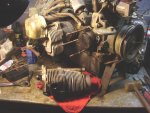Well an update. The tank sat overnight with about a gallon of gas and a pint of acetone. This morning at -4 below, I was anxious to see the results. Well I shook it and shook as the length of chain was still in there. I emptied the tank and I could not believe the greenish/brown fluid came out of it. Then I sprayed a can of oven cleaner inside of it and emptied a lobster pot of boiling water in it. I let it sit for about 20 minutes and then shook it again. more crap came out of it, but what a difference. One more rinse with $3.05 a gallon gas and one hot water rinse and it looked great. Then I blew it out with my air compressor, and put my heat gun into the fuel inlet four about 1/2 hour. Clean and dry as a bone. I reconnected the fuel lines, filled thank with a pint of trany fluid, two onces of PRI-D and a few gallons of fresh diesel. Tomorrow, I will test the glow plugs before trying to starting him! Again, thanks for all the suggestions, what a project!!! You folks are great!





